The winner – Mailchimp
Life-changing superhero
In this comparison, Mailchimp wins nine out of eleven rounds. Two rounds ends in a tie, and there no aspects in which MailPoet outperforms Mailchimp. Continue reading to learn about why are the no instances where MailPoet surpasses Mailchimp.
What Mailchimp features are better than Mailpoet?
- Comprehensive guidance
- Support for diverse email types
- Versatile segmentation
- A broader range of data and deeper insights for advanced users
- Multi-channel support
- Range of 300+ integrations
- All settings are consolidated within WordPress
- Limited range of automation campaigns
- A lack of segmentation tailored for advanced marketers
- Limited analytics
- Quick customer support feature is unavailable
- Supports email integration only
MailPoet and Mailchimp are popular email marketing platforms in the WordPress community. Established in 2001, Mailchimp is a seasoned player in the email space overall. Similarly, MailPoet, a prominent email newsletter plugin for WordPress, has gained substantial popularity.
While Mailchimp impresses with its extensive features and integrations, MailPoet is particularly well-suited for bloggers and email beginners.
Ultimately, the choice between MailPoet vs Mailchimp hinges on specific needs and budget considerations. Our extensive review compares factors such as usability, design capabilities, automation features, and pricing. This will help you make an informed decision for your business.
Let’s get started.
MailPoet vs Mailchimp: Quick overview
Mailchimp’s rating on WordPress is 4/5. Users value its intuitive interface and wide range of integrations. Additionally, Mailchimp boasts powerful automation capabilities and offers various pricing tiers.
On the other hand, MailPoet has a 4.5/5 rating on the same listing. It streamlines email workflows and simplifies the email-sending process.
These software characteristics definitely provide some basis for decision-making. However, they may not be conclusive. To provide further insight, the following table offers a quick comparison of features like signup ease, email templates, analytics, integrations, and more.
Clearly, Mailchimp provides a broader range of features compared to MailPoet. But this doesn’t mean we should disregard MailPoet entirely.
To gain a more detailed understanding of the tools, let’s explore the specifics further.
MailPoet vs Mailchimp: Feature by feature
Whether you prefer MailPoet or Mailchimp, both can elevate your email marketing efforts. Explore the details to identify which one aligns better with your specific needs.
Ease of getting started
Commencing with Mailchimp offers a quick and user-friendly experience. There’s a useful checklist guiding you on what to set up to prepare your account. In addition, users can opt for a 30-day free trial, although a credit card is required.
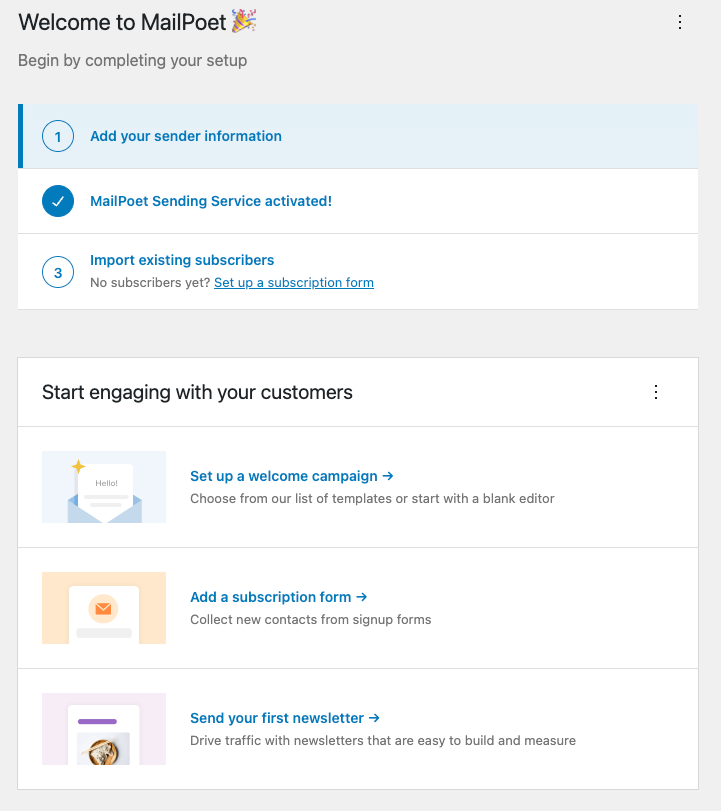
MailPoet getting started process
In contrast, MailPoet lacks a free trial but does offer a free plan. Moreover, the signup process is pretty straightforward. All users must do is download the plugin from the WP plugin library. Activation requires you to respond to five standard business-related questions.
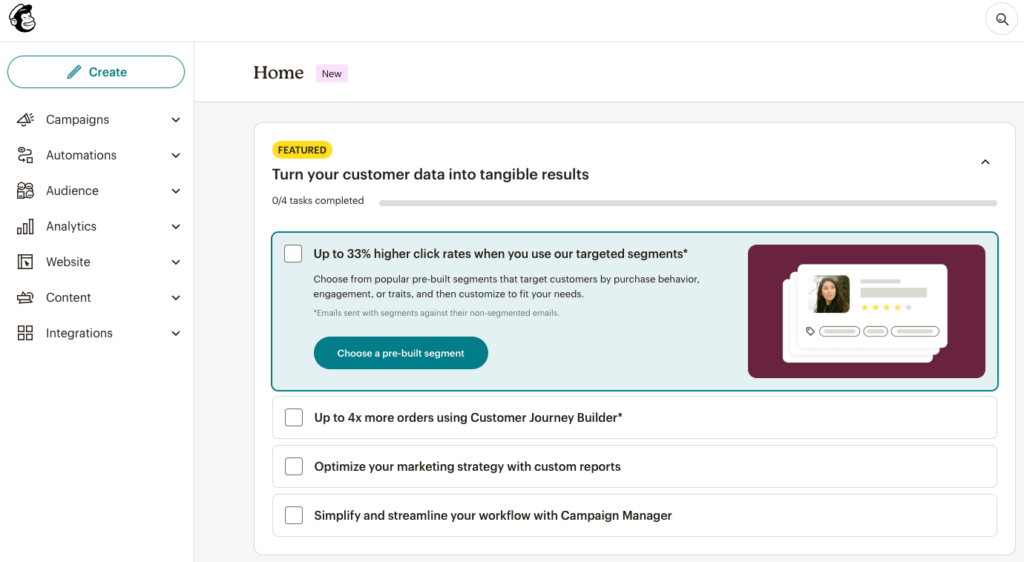
Mailchimp getting started process
An important aspect of Mailchimp is its user-friendly interface. The platform boasts intuitive navigation and a clear, crisp design.
However, both Mailchimp and MailPoet encounter challenges in locating essential features. Mailchimp’s abundance of features may prove overwhelming, particularly for beginners. Therefore, even simple tasks, such as altering the sender’s email, may pose a bit of a challenge.
Similarly, with MailPoet, all settings are consolidated within WordPress. This means that there’s too much happening in one place.
Mailchimp wins. This is because it provides comprehensive guidance, a feature that is notably absent in MailPoet.
Building an email campaign
Both Mailchimp and MailPoet provide dependable email campaign builders. Let’s explore what they have to offer.
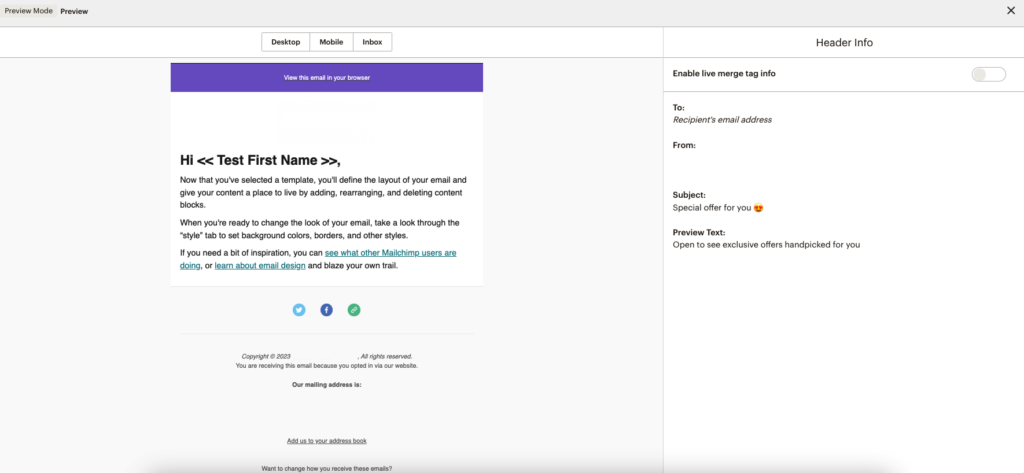
Mailchimp email editor
Mailchimp recently relaunched its campaign wizard. The newer version is more user-friendly than it already was. Here are some beneficial features found in Mailchimp’s campaign editor:
- AI assistant and subject line generator
- Capability to segment recipients within the campaign editor
- Ability to set sending time in the initial step
- Stock image library

MailPoet email editor
MailPoet’s email wizard is also clear and user-friendly. However, it lacks a button for adding emojis or AI suggestions.
Mailchimp accommodates various types of email campaigns, ranging from A/B tests to RSS campaigns. Furthermore, users can conduct multivariate tests with up to eight different options.
In contrast, MailPoet only lets you send regular newsletters and a limited range of automation campaigns.
Now, let’s explore template options. Mailchimp provides 100+ contemporary, customizable designs. For those desiring more control, there are “layouts.” Regrettably, Mailchimp’s free plan offers only six basic email templates.
In comparison, MailPoet falls short. There are only about 50 templates, some of which seem relatively basic.
Regarding personalization, MailPoet utilizes merge tags as the sole option. Mailchimp, in addition to merge tags, offers personalized product recommendations. It also includes dynamic content blocks. However, utilizing them may be challenging without the Knowledge Base.
That said, Mailchimp goes the extra mile, enabling users to:
- Send postcards
- Craft surveys
- Receive suggestions for subject lines
- Preview emails across various devices
MailPoet needs content blocks for dynamic recommendations, coupons, or any interactive elements like image carousels.
Mailchimp also provides 25 tokens for inbox previews via Litmus integration. We found this to be pretty unique.
Regarding MailPoet’s distinctive features, Automatic Latest Content stands out. This widget automatically incorporates information from your blog into emails. This is a valuable feature for bloggers, though less applicable to ecommerce.
Mailchimp continues to lead with its extensive support for diverse email types and robust features.
Marketing automation
Mailchimp vs MailPoet: Which platform excels in marketing automation?
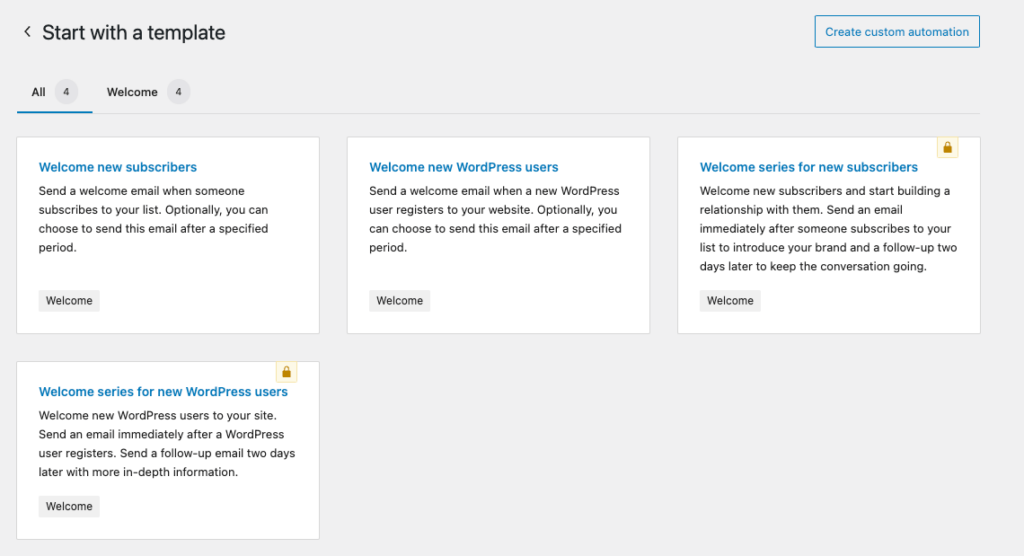
MailPoet automation
Both tools include pre-built workflows. Mailchimp offers an extensive selection with 70+ options. Similarly, MailPoet provides templates for welcoming new buyers and subscribers, cart abandonment emails, and re-engagement.

Mailchimp automation
However, when it comes to other automation features, Mailchimp holds an edge. Let’s explore why.
- Triggers: Mailchimp excels with numerous built-in triggers for various events. MailPoet offers a more limited set of only four triggers.
- Integrations: Mailchimp supports integration with popular social media platforms. Moreover, US-based users can also include SMS in their workflows. In contrast, MailPoet lacks support for integrating other marketing channels.
- Unique features: Mailchimp stands out with an AI assistant for email copywriting. It has also introduced webhooks, although this is still in beta. Conversely, MailPoet’s features are more basic.
- Analytics: Mailchimp’s Classic Automation Reports provide in-depth statistics. This includes insights relating to queue numbers and deleted automation emails. On the other hand, MailPoet’s analytics for automated journeys are more limited.
Mailchimp takes a clear lead over MailPoet in every aspect.
Signup forms and landing pages
Mailchimp and MailPoet both have room for enhancement in their list-building capabilities. That said, both have distinct strengths and weaknesses.
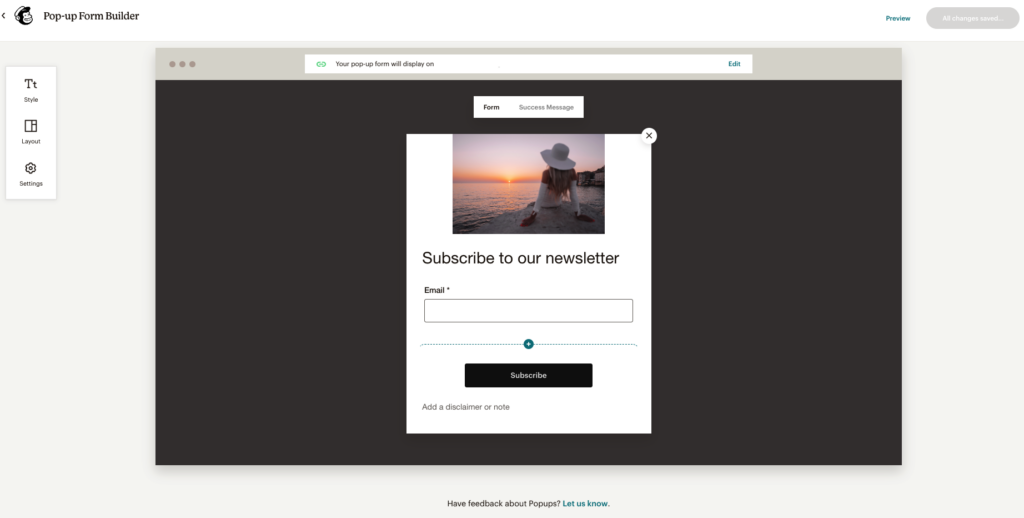
Mailchimp pop-up form builder
Starting with Mailchimp, it features one of the best landing page editors. Moreover, there are nine customizable templates that can be easily personalized.
On the downside, Mailchimp lacks pre-designed signup form templates. We found this to be a notable drawback.
Additionally, the analytics for signup form performance in Mailchimp are relatively basic. But when compared to MailPoet, which lacks performance reporting for signup forms altogether, this might not seem too bad.
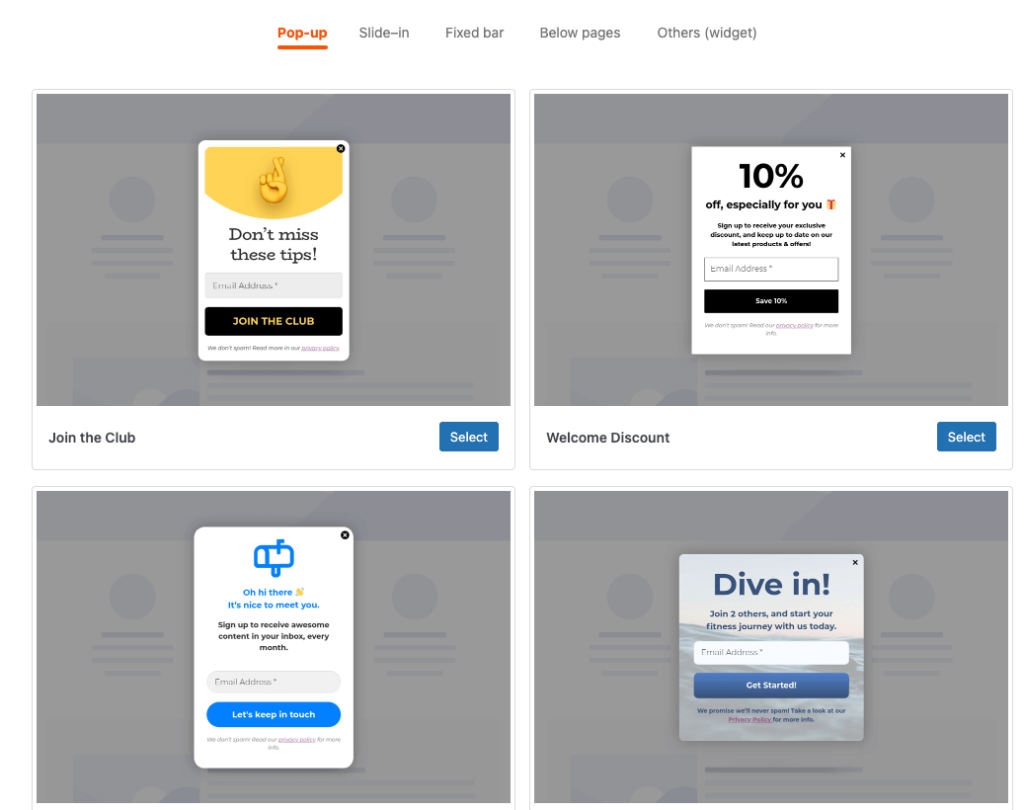
MailPoet pop-up form builder
What about MailPoet’s other features? Unlike Mailchimp, MailPoet does offer pre-built signup form templates. It offers five types of forms (popups, slide-ins, fixed bars, below-pages, and widgets) and 10 designs for each.
Overall, MailPoet’s form builder is pretty basic. However, it does include some useful features and offers various options for how the forms appear. Unfortunately, MailPoet doesn’t include a landing page builder.
List management
Managing lists on Mailchimp is uncomplicated, thanks to user-friendly subscriber tagging and segmentation.
Nonetheless, the drawback lies in Mailchimp segregating lists. This results in charges for duplicate email addresses, including unsubscribed and inactive contacts.
Similar to Mailchimp, Mailpoet provides tags for list management. We found this feature to be straightforward and user-friendly.
This round concludes in a draw. Both Mailchimp and MailPoet excel and face challenges in distinct areas.
Segmentation
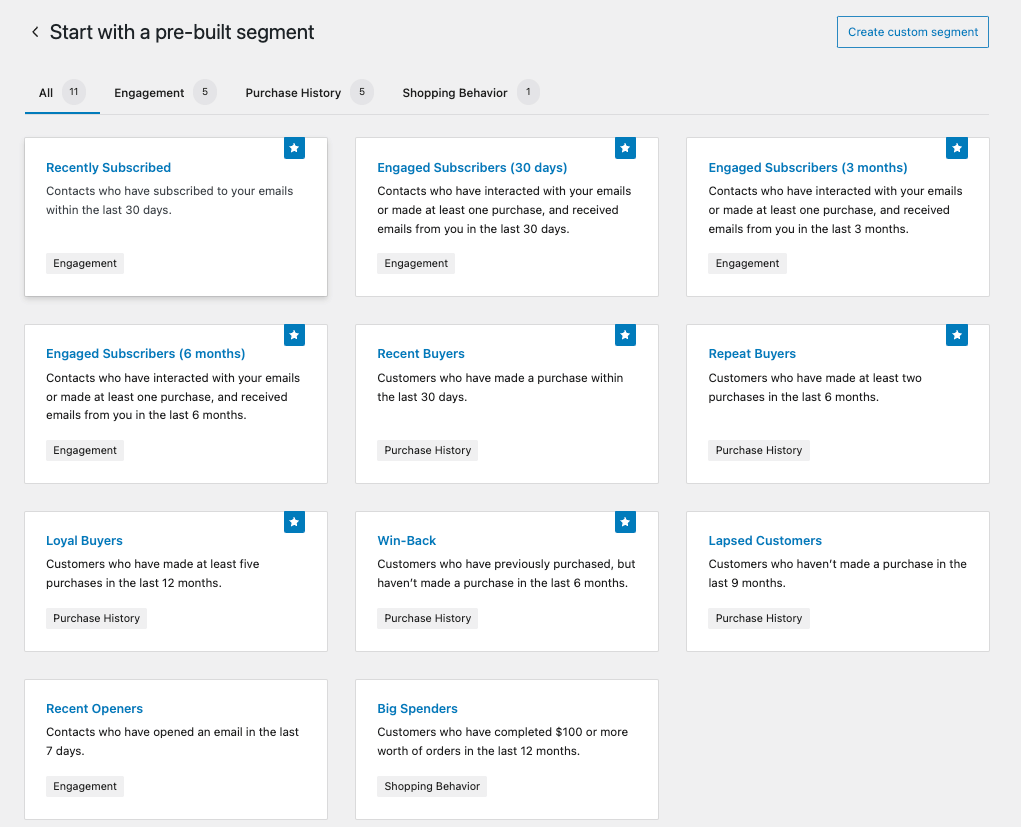
MailPoet segmentation
MailPoet provides 11 pre-built audiences to get you started. Some of the options include:
- Recently subscribed
- Engaged subscribers
- Recent or repeat buyers
- Win-back
- Recent openers
- Big spenders
While the segmentation in MailPoet is excellent for beginners, advanced marketers may need more.
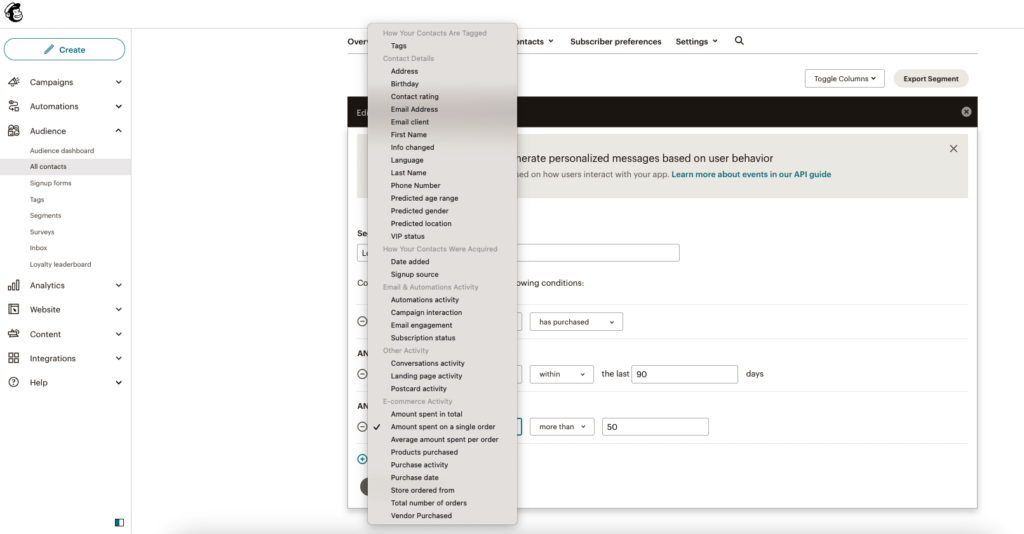
Mailchimp segmentation
In a similar vein, Mailchimp offers nine pre-built audiences for immediate segmentation. You can personalize these segments by incorporating up to five conditions for each.
For ecommerce businesses, Mailchimp’s segmentation options prove highly beneficial. It provides segmentation based on:
- Purchase history
- Order value
- Specific product categories
But regardless of whether you opt for Mailchimp or MailPoet, you’ll face a common drawback. Both platforms lack on-site behavior segments, such as browse and cart abandonment.
Mailchimp’s segmentation is more versatile.
Analytics
Mailchimp’s analytics may not provide comprehensive insights into some areas. However, users can still access basic metrics relating to:
- Open and click rates
- Social media and landing page engagement
- Campaign forwarding
Premium plan users enjoy additional benefits with access to comparative reports. These offer valuable insights into both regular and RSS campaigns.
In contrast, MailPoet’s analytics are rather limited. You can retrieve your newsletter’s stats report after it’s sent, along with a welcome email and WooCommerce reports. The available information includes standard email metrics like opens and clicks, as well as clicked links in the campaign.
However, there are no comprehensive sales reports, real-time analytics, or geolocation reports.
Additionally, MailPoet lacks unique features found in Mailchimp. For instance, Mailchimp allows users to export data for a specific audience within a defined time frame. The website report also highlights unique anonymous visits and the resulting subscriber count.
Mailchimp surpasses MailPoet, offering a broader range of data and deeper insights for advanced users.
Customer support
A robust customer support team is crucial as it prevents any potential roadblocks. Moreover, it guarantees maximum utilization of the tool.
Mailchimp’s customer support varies by plan. Here’s a quick overview:
- Free plan: Email support for the initial 30 days
- Paid plans (Mailchimp Essentials and Standard): 24/7 email and chat support
- Premium plan: Priority support through email, chat, and phone
We tried Mailchimp’s live chat support and found it to be quite responsive. We had a response to our query in just 2-3 minutes.
Regarding MailPoet, free plan users can seek help in the WordPress support forum. On the other hand, paid plan users enjoy email support from Monday to Friday. They can also contact the MailPoet support team through an online form.
The platform claims that users will receive a response to their queries within 48 hours. However, this might not be helpful when you need a quick response.
Luckily, both platforms have an elaborate online help center. This includes educational videos, blog articles, and platform guides.
Mailchimp leads this round by offering multi-channel support, a feature absent in MailPoet.
Integrations
Mailchimp offers an extensive range of 300+ integrations, spanning diverse categories, including:
- Ecommerce
- Contact management
- Design and content
- List building
Notably, Mailchimp for WooCommerce is also among its offerings. In contrast, MailPoet is designed exclusively for WooCommerce and WordPress. So, there are a few plugins that can be integrated with MailPoet.
However, MailPoet doesn’t actively maintain or support these integrations. Users might have to rely on the plugin developers or community support for assistance with these integrations.
Mailchimp wins this round with its wide range of native integrations.
Compatibility with other marketing channels
In terms of compatibility, Mailchimp stands out. It seamlessly integrates with channels such as:
- SMS
- Facebook and Instagram
- Google Analytics
Unfortunately, Mailchimp lacks support for web push and app push notifications. In the case of MailPoet, it supports email only.
The verdict is once again in favor of Mailchimp. This is because Mailchimp outperforms MailPoet in terms of native integrations.
Generative AI tools
Following its acquisition by global tech leader Intuit, Mailchimp has increased its emphasis on AI-powered tools.
In 2023, Mailchimp launched Intuit Assist, a marketing assistant powered by GenAI. It facilitates content generation, personalized marketing, and strategy refinement. All of this is made possible through insights derived from customer data.
Excitingly, the tool has new upcoming capabilities. This includes the automatic creation of ecommerce automations and segmentations guided by natural language prompts.
MailPoet has yet to roll out any AI tools.
Undoubtedly, Mailchimp wins.
Price Comparison
As we wrap up our MailPoet vs Mailchimp comparison, let’s explore their free and paid plans. Which one offers better value for your money?
Free plans comparison
Whether you go with MailPoet or Mailchimp, both offer free plans. Let’s examine what each includes:
- Send up to 5,000 emails to 1,000 subscribers per month
- Pre-built signup forms and list management features
- Basic marketing automation
- 70+ email templates
- Transactional emails
- Basic segmentation and email engagement statistics
- WordPress forums and Knowledge Base
- Sender authentication
- Send up to 1,000 emails to 500 contacts per month (capped at 500 per day)
- Signup forms, surveys, and landing pages
- Audience overview dashboard
- Basic email templates
- Social posting, Facebook and Instagram ads
- Basic segmentation and analytics
- Email support for the initial 30 days
- Personalized product recommendations
It seems like Mailchimp’s free plan mainly caters to marketers. If you own an ecommerce business, you’ll probably need to upgrade to a paid plan.
Regarding MailPoet, its free plan boasts ample features. Furthermore, the monthly email-sending limit surpasses that of many other marketing platforms’ free plans.
Paid plans comparison
Whether you decide on Mailchimp or MailPoet, both platforms operate on a tiered pricing model. This is determined by your subscriber count and required features. As you move up the tiers, costs increase, granting access to advanced features and expanded subscriber limits.
A notable distinction, however, lies in the email-sending limits. Mailchimp imposes a monthly limit on paid plans, while MailPoet provides unlimited emails.
Now, let’s examine the monthly costs for both tools.
The pricing of both platforms might seem reasonable for a small subscriber list. But as your subscriber count expands, the costs increase substantially.
For enhanced flexibility, Mailchimp provides a pay-as-you-go model. Interestingly, MailPoet offers a plan called Creator, starting at $8 per month. This plan replicates the Business plan but doesn’t include the MailPoet Sending Service.
This service is tailored to manage WordPress demands, sending your emails efficiently. Without it, you would need to send emails through your web host.
Nonprofits benefit from special discounts on both platforms. MailPoet extends a 20% discount on all its plans, while Mailchimp provides a 15% nonprofit discount. However, note that Mailchimp’s discounts exclude third-party purchases like postcards, ads, and domains.
MailPoet vs Mailchimp: Which one wins?
Let’s swiftly summarize the Mailchimp vs MailPoet comparison to assist you in making an informed decision.
3.0
4.5
500 subscribers – $10
2,500 subscribers – $30
5,000 subscribers – $55
10,000 subscribers – $80
50,000 subscribers – $290
100,000 subscribers – $550
500 subscribers – $13
2,500 subscribers – $45
5,000 subscribers – $75
10,000 subscribers – $110
50,000 subscribers – $385
100,000 subscribers – N/A
– 5,000 email sends/mo
– 1,000 subscribers
– 70+ email templates
– Well-equipped email and forms editors
– Basic segmentation and analytics
– Transactional emails
– Signup forms
– No advanced segmentation and analytics, and email support
– 1,000 email sends/mo
– 500 subscribers
– 300+ integrations
– Basic email templates
– Basic analytics and segmentation
– Forms and landing pages
– Email support for 30 days
– No email scheduling, advanced segmentation, and comparative reporting
– User-friendly
– Cost-effective
– Provides all essential functions for beginners
– Comprehensive feature set
– Many integrations; easy to integrate with various toolkit
– User-friendliness
– Limited analytics depth
– Lack of ecommerce-specific templates
– Absence of landing pages and Gen AI tools
– No live chat or phone support
– Extra charges for email duplicates; additional cost if a subscriber is on two lists
– Free plan provides minimal features
– Paid plans become costly as the subscriber list expands
– Basic email templates in the free plan
– WordPress and WooCommerce users
– Beginners
– Bloggers
– Startup owners
– Solopreneurs
– Startups
– Bloggers
– Non-profit organizations
– Established ecommerce businesses and solopreneurs
– Growing ecommerce stores
Deciding between MailPoet vs Mailchimp doesn’t need to be complex. This is because their unique features and pricing structures set them apart.
For WordPress blog users, MailPoet is a compelling choice for email marketing. Moreover, the platform’s paid plans offer unlimited email sends. This is a great benefit if you anticipate working with large email volumes.
On the other hand, Mailchimp is a solid option if you seek a diverse range of features and integrations. And again, with eight wins in 10 rounds and two ties, it’s evident which platform holds a stronger position.
However, neither MailPoet nor Mailchimp can fully meet all ecommerce needs. For ecommerce businesses on Woocommerce, exploring other alternatives could be worthwhile.
Read full reviews
Related picks for you
Our team strives to be accurate and unbiased in reviewing email tools. However, we recognize that mistakes can happen, and it’s essential for us to stay up to date. If you come across any errors or things that need to be reviewed again, please let us know.





Leave a Reply